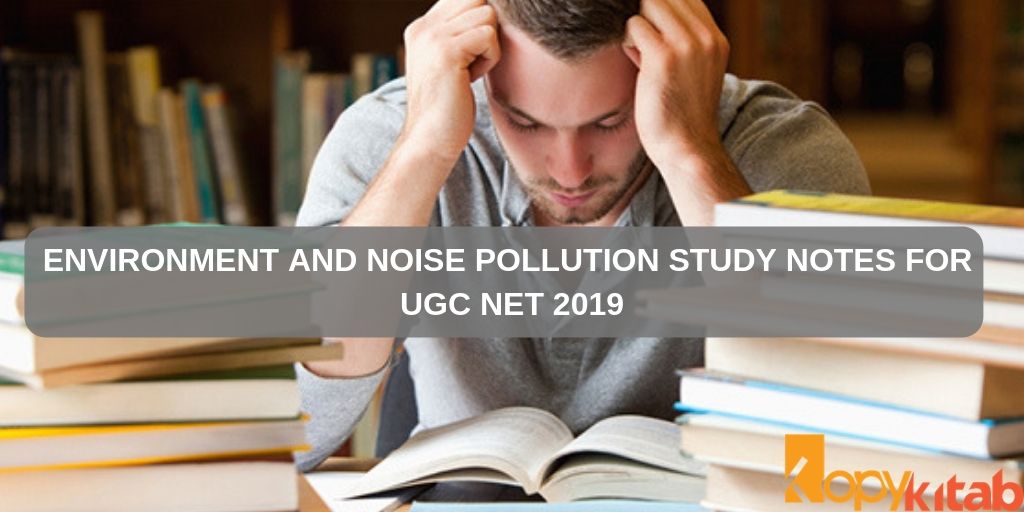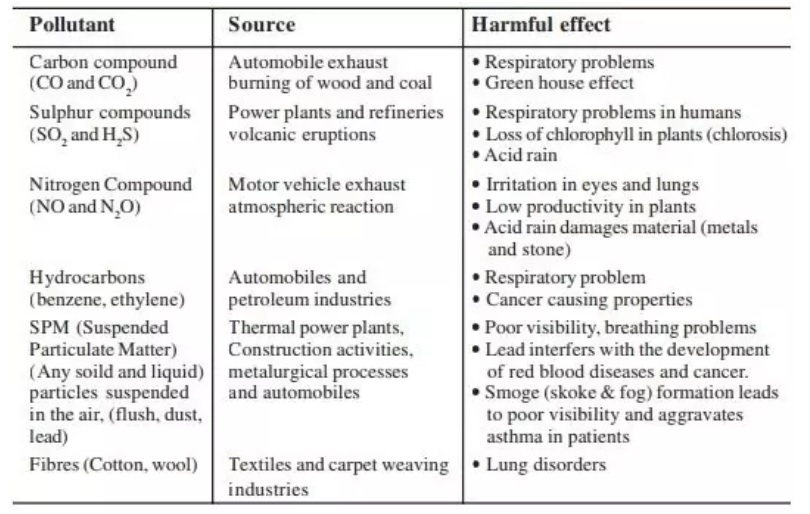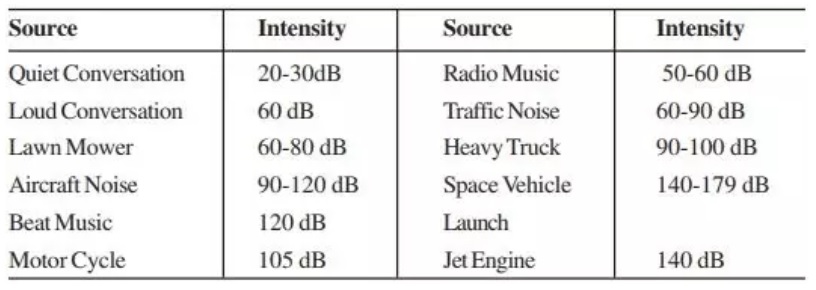
UGC NET examination conducted by the National Testing Agency (NTA) is one of the topmost competitive examinations which is conducted for candidates to become eligible for Junior Research Fellowship (JRF) and Assistant Professor. The UGC NET Exam 2019 is scheduled from June 20, 2019. As the UGC NET syllabus is vast, preparation needs to be at high levels. Environment and Noise Pollution is one of the tough subjects in UGC NET Syllabus. To ease out candidates preparation in this subject, we are providing UGC NET Environment and Noise Pollution Study Notes. Here is the detailed explanation of notes designed by a panel of experts. Go through the blog to know more about Environment and Noise Pollution Study Notes
Environment and Noise Pollution Study Notes
Air and Noise Pollution
Developmental activities such as construction, transportation, and manufacturing not only deplete the natural resources but also produce a large number of wastes that lead to pollution of air, water, soil, and oceans; global warming and acid rains.
Pollution & Pollutants
Automobiles emit from their tailpipes oxides of nitrogen, sulphur dioxide, carbon dioxide, carbon monoxide and a complex mixture of unburnt hydrocarbons and black soot which pollute the atmosphere. Domestic sewage and run-off from agricultural fields, laden with pesticides and fertilizers, pollute water bodies. Effluents from tanneries contain many harmful chemicals and emit a foul smell.
- Pollution may be defined as the addition of undesirable material into the environment as a result of human activities. The agents which cause environmental pollution are called pollutants.
- Pollutants may be defined as a physical, chemical or biological substance unintentionally released into the environment which is directly or indirectly harmful to humans and other living organisms.
Types of Pollution
Pollution may be of the following types
- Air pollution
- Noise pollution
- Water pollution
- Soil Pollution
- Thermal Pollution
- Radiation Pollution
Air Pollution
Air Pollution may be defined as the presence of any solid, liquid or gaseous substance including noise and radioactive radiation in the atmosphere in such concentration that may be directly and indirectly injurious to humans or other living organisms, plants, property or interferes with the normal ecological processes. Air Pollutants are of two types:
- Suspended particulate matter, and
- gaseous pollutants like carbon dioxide (CO2), Nox, etc.
Some of the major air pollutants, their sources and effects are given in the below table
| Pollutant | Sources | Effects |
| Suspended particulate | Smoke from domestic, matter/dust industrial and vehicular soot | Reduces sunlight and visibility, increase corrosion, pneumoconiosis, asthma, cancer, and other lung diseases. |
| Fly ash | Part of smoke released from settles down on vegetarian, houses. Adds chimneys of factories and to the suspended participate matter (SPM) power plants. | Leachates contain harmful material |
Particulate Pollutants
Particulate matter suspended in air is dust and soot released from the industrial chimneys. Their size ranges from 0.001 to 500 micrometer in diameter. Particles less than 10-micrometer float and move freely with the air current. Particles which are more than 10 micrometers in diameter settle down. Particles which are less than 0.02-micrometer form persistent aerosols. A major source of SPM are vehicles, power plants, construction activities, oil refinery, railway yard, market place, industries, etc.
Fly Ash
Fly ash is ejected mostly by the thermal power plants as by-products of coal burning operations. Fly ash pollutes air and water and may cause heavy metal pollution in water bodies. Fly ash affects vegetarian as a result of its direct deposition on leaf surfaces or indirectly through its deposition on the soil. Fly ash is now being used for making bricks and as landfill material.
Lead and other metals particles
- Tetraethyl lead (TEL) is used as an anti-knock agent in petrol for a smooth and easy running of vehicles. The lead particles coming out from the exhaust pipes of vehicles is mixed with air.
- Lead mixed with water and food can create cumulative poisoning. It has long term effects on children as it lowers intelligence.
- Oxides of Iron, aluminum, manganese, magnesium, zinc, and other metals have an adverse effect due to deposition of dust on plants during mining operations and metallurgical processes.
Gaseous Pollutants
Power plants, industries, different types of vehicles- both private and commercial use petrol, diesel as a fuel and release gaseous pollutants such as carbon dioxide, oxides of nitrogen and sulphur dioxide along with particulate matter in the form of smoke. All of these have harmful effects on plants and humans.
Gaseous air pollutants: their sources and effects
Noise Pollution
- A musical clock may be nice to listen during the day, but maybe an irritant during sleep at night. Noise by definition is ‘sound without value’ or ‘any noise that is unwanted by the recipient’
- Noise level is measured in terms of decibels (dB). W.H.O. (World Health Organization) has prescribed optimum noise level as 45 dB by day and 35 dB by night. Anything above 80 dB is hazardous.
- Noise in industries such as stone cutting and crushing, steel forgings, loudspeakers, shouting by hawkers selling their wares movement of heavy transport vehicles, railways and airports leads to irritation and an increased blood pressure, loss of temper, decrease in work efficiency, loss of hearing which may be first temporary but can become permanent in the noise stress continues.
Sources of some noises and their intensity
Sources of Noise Pollution
- Noise pollution is a growing problem. All human activities contribute to noise pollution to a varying extent. Sources of noise pollution are many and may be located indoors or outdoors.
- Indoor Sources include noise produced by radio, television. generators, electric fans, air coolers, air conditioners, different home appliances, and family conflict.
- Outdoor sources of noise pollution include indiscriminate use of loudspeakers, industrial activities, automobiles, rail traffic, airplanes and activities such as those at marketplace, religious, social, and cultural functions, sports and political rallies.
Prevention and control of noise pollution
Following steps can be taken to control or minimize noise pollution:
- Road traffic noise can be reduced by better designing and proper maintenance of vehicles.
- Noise abatement measures include creating noise mounds, noise attenuation walls and well-maintained roads and smooth surfacing of roads.
- Retrofitting of locomotives, continuously welded rail track, use of electric locomotives or deployment of quieter rolling stock will reduce noises emanating from trains.
- Air traffic noise can be reduced by appropriate insulation and introduction of noise regulations for take-off and landing of aircraft at the airport.
- Industrial noises can be reduced by soundproofing equipment like generators and areas producing a lot of noise.
- A green belt of trees is an efficient noise absorber.
Thus, candidates who are appearing for the upcoming UGC NET Exam, are suggested to go through the Environment and Noise Pollution Study Notes to score more. Also, ensure that you refer to the best UGC NET Preparation Books.
[related_books catid=”533″ product_type=”ebook” algo=”Latest”]

